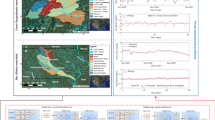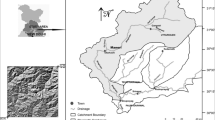Abstract
An application of a Nonlinear Autoregressive Exogenous Neural Network (NARX) to predict total suspended sediment concentrations (SST) for a water body located in central Chile (Francia Creek, Valparaiso) is presented. Input data consisting of precipitation and stream flow time-series were fed to the developed NARX, for prediction of daily SST concentrations for a whole year. Sensitivity analysis was used for achieving the best NARX configuration that provided the best fit of simulated vs. measured data for year 2014. Parameters varied during sensitivity analysis were: number of nodes, number of iterations, feedback and forward delays, years of daily data used as training dataset. The resulting NARX is an open-loop net, consisting of a 12-node hidden layer, 100-iterations, using the Bayesian regularization backpropagation algorithm. SST concentrations predicted by the NARX net agreed successfully with measured SST concentrations (r = 0.73, r2 = 0.53, NSE = 0.18, PBIAS = −13.6%, Index of Agreement = 0.87).
Access this chapter
Tax calculation will be finalised at checkout
Purchases are for personal use only
Similar content being viewed by others
References
Xu, N., Saiers, J.E., Wilson, H.F., Raymond, P.A.: Simulating streamflow and dissolved organic matter export from a forested watershed. Water Resources Res. 48(5), Article number W05519 (2012)
Xu, C.Y., Xiong, L., Singh, V.P.: Black-Box hydrological models. In: Duan, Q., Pappenberger, F., Thielen, J., Wood, A., Cloke, H., Schaake, J. (eds.) Handbook of Hydrometeorological Ensemble Forecasting, pp. 1–48. Springer, Heidelberg (2017). https://doi.org/10.1007/978-3-642-40457-3_21-1
Nacar, S., Hınıs, M.A., Kankal, M.: Forecasting daily streamflow discharges using various neural network models and training algorithms. KSCE J. Civil Eng. 22(9), 3676–3685 (2018). https://doi.org/10.1007/s12205-017-1933-7
Dariane, A.B., Azimi, S.: Streamflow forecasting by combining neural networks and fuzzy models using advanced methods of input variable selection. J. Hydroinform. 20(2), 520–532 (2018). https://doi.org/10.2166/hydro.2017.076
Daliakopoulos, I.N., Tsanis, I.K.: Comparison of an artificial neural network and a conceptual rainfall–runoff model in the simulation of ephemeral streamflow. Hydrol. Sci. J. 61(15), 2763–2774 (2016). https://doi.org/10.1080/02626667.2016.1154151
Besaw, L.E., Rizzo, D.M., Bierman, P.R., Hackett, W.R.: Advances in ungauged streamflow prediction using artificial neural networks. J. Hydrol. 386(1–4), 27–37 (2010). https://doi.org/10.1016/j.jhydrol.2010.02.037
Halecki, W., Kruk, E., Ryczek, M.: Estimations of nitrate nitrogen, total phosphorus flux and suspended sediment concentration (SSC) as indicators of surface-erosion processes using an ANN (Artificial Neural Network) based on geomorphological parameters in mountainous catchments. Ecol. Ind. 91, 461–469 (2018). https://doi.org/10.1016/j.ecolind.2018.03.072
Meral, R., Dogan Demir, A., Cemek, B.: Analyses of turbidity and acoustic backscatter signal with artificial neural network for estimation of suspended sediment concentration. Appl. Ecol. Environ. Res. 16(1), 697–708 (2018). https://doi.org/10.15666/aeer/1601_697708
Sari, V., dos Reis Castro, N.M., Pedrollo, O.C.: Estimate of suspended sediment concentration from monitored data of turbidity and water level using artificial neural networks. Water Resources Manag. 31(15), 4909–4923 (2017). https://doi.org/10.1007/s11269-017-1785-4
Bhattacharya, B., Van Kessel, T., Solomatine, D.P.: Spatio-temporal prediction of suspended sediment concentration in the coastal zone using an artificial neural network and a numerical model. J. Hydroinform. 14(3), 574–584 (2012). https://doi.org/10.2166/hydro.2012.123
Alarcon, V.J., Magrini, C.: Scenarios of sediment transport management in Francia Creek, Valparaiso, Chile. In: Gervasi, O., et al. (eds.) ICCSA 2018. LNCS, vol. 10962, pp. 205–218. Springer, Cham (2018). https://doi.org/10.1007/978-3-319-95168-3_14
Moriasi, D.N., Arnold, J.G., Van Liew, M.W., Bingner, R.L., Harmel, R.D., Veith, T.L.: Model evaluation guidelines for systematic quantification of accuracy in watershed simulations. Trans. ASABE 50(3), 885–900 (2007)
Krause, P., Boyle, D.P., Bäse, F.: Comparison of different efficiency criteria for hydrological model assessment. Adv. Geosci. 5, 89–97 (2005). https://doi.org/10.5194/adgeo-5-89-200
Author information
Authors and Affiliations
Corresponding author
Editor information
Editors and Affiliations
Rights and permissions
Copyright information
© 2019 Springer Nature Switzerland AG
About this paper
Cite this paper
Alarcon, V.J. (2019). Predicting Sediment Concentrations Using a Nonlinear Autoregressive Exogenous Neural Network. In: Misra, S., et al. Computational Science and Its Applications – ICCSA 2019. ICCSA 2019. Lecture Notes in Computer Science(), vol 11621. Springer, Cham. https://doi.org/10.1007/978-3-030-24302-9_42
Download citation
DOI: https://doi.org/10.1007/978-3-030-24302-9_42
Published:
Publisher Name: Springer, Cham
Print ISBN: 978-3-030-24301-2
Online ISBN: 978-3-030-24302-9
eBook Packages: Computer ScienceComputer Science (R0)




